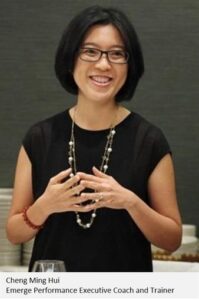
What does an executive coach do? Can they swoop in and solve all your problems? Should you seek their help only when you’re struggling at work? If you’re enjoying a successful career, why would you bother with a coach?
If you’ve ever had such questions, you’re not alone. To shed light on these topics, we had a Q&A session with Cheng Ming Hui, an Emerge Performance

coach and experienced trainer and facilitator with a strong corporate background.
Read on to learn how coaches like Ming Hui can help you boost your professional performance and become a better leader.
Q: How do you describe/explain executive coaching?
My favourite description of executive coaching comes from Karol Wasylyshyn in “The Talent Management Handbook: Creating Organizational Excellence By Identifying, Developing, and Promoting Your Best People”. Wasylyshyn defines it as “a customized and holistic development process that provides deep behavioural insights intended to accelerate an executive’s business results and effectiveness as a leader”.
This is a process built upon trust, collaboration and co-creation. What I appreciate most about executive coaching is that it may begin in a professional or organisational context, but often the coachee ends up benefitting on a personal level as well.
Q: Why should an executive consider hiring a coach?
Well, because, as Bill Gates said, “Everyone needs a coach”!
High-performing individuals know that a coach can help them unlock behavioural insights, reflect, gain clarity and ultimately take purposeful action to achieve the betterment that they are seeking. A coach inspires, challenges and holds the individual accountable so that insights are translated into actions and progress is tracked.
In a world where everyone is expected to do more with less, executives may not have the time or space to pin down the one or two factors that would make a difference and take them from good to better to great – even when they know that it is within them. A professional coach fills the gap to catalyse and facilitate this process.
Q: What are some of the misconceptions about executive coaching?
The biggest misconception is that coaching is needed only when something goes wrong. Organisations that package executive coaching with performance assessments (especially those that don’t go too well) further feed into this view. In contrast, high performers do not engage a coach only when something goes wrong; they do so to up their game and improve on the status quo.
Another misconception closely linked to the first is that the coach will “fix things”. If you hire a personal trainer, you share your fitness goals and then your trainer helps you determine whether they are realistic, practical and suit your current health status. Together you finetune your goals and develop a plan for recurring practice. Your trainer guides, encourages and challenges, and occasionally gives you a nudge or two. But you have to be the one taking the action and putting in the commitment. You have to believe in the process, accept the lapses, and bounce back and push on. If you do, then there’s a high probability of success. Coaching is no different.

Q: What type of clients do you work with as an executive coach?
I work with corporate managers and executives who are looking to be even more successful, effective, and fulfilled in their work and lives.
For example, new managers may find that the skills and traits that got them promoted may not bring them the same success as management. Young executives may be looking for ways to prove themselves ready for the next big break. Experienced leaders may find themselves facing a bottleneck or crossroads in terms of their work performance or the balance in their life. As Marshall Goldsmith put it, “What got you here won’t get you there”.
Q: What does a typical executive coaching engagement look like? Are there key steps or a general process that you use when coaching, or is every engagement fully customised to the needs of your client?
There are many coaching models available out there, and certainly no shortage of tools, from self-assessments to 360-degree questionnaires to myriad guides and checklists. Apart from that, there are various sciences and behavioural theories that can be infused into coaching sessions. The choice of which process and tool is therefore dependent on what the client needs. So while two clients may use the same set of tools and process, no two journeys, flows or outcomes would be the same.
That said, regardless of the model and process adopted, there are some principles in coaching that are largely universal. First, establishing a coaching relationship built on trust in a safe environment is fundamental. The relationship should centre on the coachee’s needs and goals, including those that they may not have discovered yet! It’s also important to note that focusing on the coachee includes the social and dynamic environment that they are in – it is a holistic versus isolated type of focus.
The coach’s role is to listen deeply, distil, probe, encourage and challenge – all with the intent of expanding the coachee’s awareness, exploring possibilities and co-creating action plans. Finally, there needs to be commitment from the coachee while the coach supports the process and commitment by holding them accountable. This last principle is critical for a successful outcome in coaching – that a coachee sees the result of the journey they embark on.
Q: What does a typical coaching session look like? How frequently do you have sessions with a client, and how long does a coaching engagement last?
The short answer is that it varies, and it’s easy to see why since every individual is unique. That said, to see sustainable results, we at Emerge Performance recommend a minimum of five sessions.
The frequency ought to be set in a way that allows space for a prior meeting’s takeaways to be processed before the next meeting, so a time window of about a month is not unusual. Of course, this also depends on the type of program. For instance, the Marshall Goldsmith Stakeholder-Centered Coaching program has a highly structured approach of defined steps over a period of 9–12 months.

Q: What are some of the common outcomes that a client can expect from working with an executive coach?
Ultimately, an individual’s effectiveness in the targeted area will be boosted, and often this translates into improved business performance since executive coaching closely links professional performance to that of the business organisation.
Improvement may be seen in areas such as strategic decision-making, courage to innovate, managing team relationships or navigating change. Each of these contributes positively to the bottom line of the business and to an individual’s personal and career development.

Striving higher with personalised support
Just as elite athletes have coaching teams to help them reach the pinnacle of their sport, many business leaders work with executive coaches to help
boost their performance. By building trust, offering fresh perspectives and providing personalised support, coaches like Ming Hui help corporate
managers and executives become stronger both professionally and personally.
Wherever you are currently in your career, there’s potential for bigger and better things inside you – and a coach can help you unleash it.